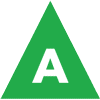Translate this page to any language by choosing a language in the box below.
The classification letters on fire exxtinguishers can be confusing, but it is important to use the right type of fire extinguisher for the type of fire you are trying to put out. The chart below should make it easy to select the best type of fire extinguisher for your home or office.
Classification of Fire Extinguishers
There are five general classifications of fires and extinguishing agents. They are each designed to put out different kinds of fires.
 |
 |  |  |
 |
For use with ordinary materials like cloth, wood and paper. Class A fires are those that involve ordinary combustible materials such as wood, paper, cloth, rubber and plastics. The quenching and cooling effects of water or of solutions containing large amounts of water are the most effective means of extinguishing this type of fire Often used in homes and businesses |
For use with combustible and flammable liquids like grease, gasoline, oil and oil-based paints. Class B fires are those that occur in the vapor-air mixture over the surface of flammable liquids such as gasoline, oil, grease, paints and thinners. The limiting of air (oxygen) or the combustion inhibiting effect is the most effective measure against incipient fires of this class. Water must not be used on Class B fires because it tends to spread the fire. Often used in homes and businesses | For use with electrical equipment like appliances, tools, or other equipment that is plugged in. Class C fires are those that occur in or near energized electrical equipment where non-conducting extinguishing agents must be used. Water must never be used on Class C fires. Often used in homes and businesses | For use with flammable metals Class D fires are those that involve combustible metals such as magnesium, titanium, zirconium and sodium. Water must never be used on class D fires. A Class D powdered extinguishing agent should be used. Often used in factories |
For use with vegetable oils, animal oils and fats in cooking appliances.
Often used in commercial kitchens (restaurants, cafeterias, catering businesses) |



There are also multipurpose fire extinguishers that might be labeled "B-C" or "A-B-C." Most Big Box stores and home improvement stores, like Home Depot and Lowes, carry multipurpose fire extinguishers that cover Class A through Class C. The A-B-C type fire extinguishers are usually the best choose for use in homes.
| Light(Low)Hazard Occupancy | Ordinary(Moderate)Hazard Occupancy | Extra(High)Hazard Occupancy | |
| Minimum rated single extinguisher | 2-A | 2-A | 4-A* |
| Maximum floor area per unit of A | 3,000 sq ft** | 1,500 sq ft. | 1,000 sq ft. |
| Maximum floor area for extinguisher | 11,250 sq ft** | 11,250 sq ft** | 11,250 sq ft** |
| Maximum travel distance to extinguisher | 75 ft. | 75 ft. | 75 ft. |
* Two 2 1/2 gallon (9.46 L) water type extinguishers can be used to fulfill the requirements of one 4-A rated extinguisher.
** See pamphlet 10, Portable Fire Extinguishers, National Fire Protection Association, 1981 Edition.
Other than for Fires in Flammable Liquids of Appreciable Depth
| Type of Hazard (m 2 ) | Basic Minimum Extinguisher Rating | Maximum Travel Distance to Extinguishers (ft.) |
| Light (Low) | ||
|
5B | 30 |
|
10B | 50 |
| Ordinary (Moderate) | ||
|
10B | 30 |
|
20B | 50 |
| Extra (High) | ||
|
40B | 30 |
|
80B | 50 |
Extinguishers with Class C rating shall be required where energized electrical equipment may be encountered which would require a non-conducting extinguishing medium. This will include fire either directly involving or surrounding electrical equipment. Since the fire itself is a Class A or Class B hazard, the extinguishers are sized and located on the basis of the anticipated Class A or B hazard.
Ways to save money AND help the environment:
Eat healthier AND save money: Instant Pot Duo Crisp 11-in-1 Air Fryer and Electric Pressure Cooker Combo with Multicooker Lids that Fries, Steams, Slow Cooks, Sautés, Dehydrates
Save water AND money with this showerhead adapter, it lets the water flow until the water is hot, then shuts off water flow until you restart it, ShowerStart TSV Hot Water Standby Adapter
Protect your health with these:
Mattress Dust mite-Bedbug protector, 100% Waterproof, Hypoallergenic, Zippered
Handheld Allergen Vacuum Cleaner with UV Sanitizing and Heating for Allergies and Pet, Kills Mite, Virus, Molds, True HEPA with Powerful Suction removes Hair, Dander, Pollen, Dust,
Immune Support Supplement with Quercetin, Vitamin C, Zinc, Vitamin D3
GermGuardian Air Purifier with UV-C Light and HEPA 13 Filter, Removes 99.97% of Pollutants
5 Stage Air Purifier, Features Ultraviolet Light (UVC), H13 True Hepa, Carbon, PCO, Smart Wifi, Auto Mode, Quiet, Removes 99.97% of Particles, Smoke, Mold, Pet Dander, Dust, Odors
Interesting Reads:
THE PREPPER'S CANNING & PRESERVING BIBLE: [13 in 1] Your Path to Food Self-Sufficiency. Canning, Dehydrating, Fermenting, Pickling & More, Plus The Food Preservation Calendar for a Sustainable Pantry
The Backyard Homestead: Produce all the food you need on just a quarter acre! Paperback
The Citizens' Guide to Geologic Hazards: A Guide to Understanding Geologic Hazards Including Asbestos, Radon, Swelling Soils, Earthquakes, Volcanoes
The Uninhabitable Earth: Life After Warming
Book: The Sixth Extinction: An Unnatural History Paperback